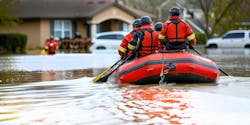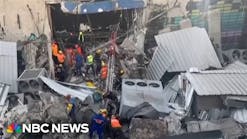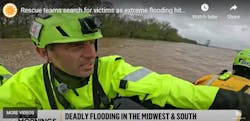One of the fastest-growing areas of hazardous materials transportation is that of intermodal containers. During 2003, a total of 9,502,563 intermodal containers were shipped by rail and 1,227,852 were shipped on highways, and the U.S. Department of Transportation (DOT) forecasts that total tons of hazardous materials transported will grow by 2% per year. However, growth of transport by intermodal containers is forecast to be three times faster.
The use of intermodal containers is referred to by the DOT as "intermodalism," which means "the use of more than one form of transportation." Intermodal containers resemble many of the other bulk transportation containers found in highway, rail and water modes of transportation, but are smaller in capacity. They are designed to be transported in rail, water and highway modes without the need to off-load the products; that is, the container is transferred from one mode of transportation to another rather than the product being transferred from one container to another.
When aboard a ship, intermodal containers may be found above or below deck. Once a container ship reaches port, the intermodal containers are unloaded by giant cranes. The containers may also be shipped on inland waterways aboard barges. Containers are moved around on land by specially designed forklift-type vehicles that are much larger than a typical forklift. Containers may be found stacked on top of each other on the dock awaiting further shipment on land. From the dock the containers are moved inland by rail or truck.
Intermodal containers are not usually transferred directly from ship to rail or truck. They are unloaded onto the dock and then transferred to rail or truck by specially designed cranes. An added advantage to intermodal containers is that they are portable and can be taken to the end-use site and off-loaded as a stationary storage tank until the product is used up and then returned for refilling.
Intermodal containers are regulated by the DOT and containers are made to specifications prepared by the International Maritime Organization (IMO), an agency of the United Nations that deals with treaties for maritime safety among other matters. Primarily IMO Specification 1, 2, 5 and 7 tank containers are used to transport hazardous materials.
Intermodal containers come in many sizes and shapes. Box containers may be found in varying lengths from 10 to 48 foot lengths. Typical heights are eight feet, six inches, but some styles may vary from eight feet to nine feet, six inches. The standard width of intermodal containers is eight feet. Containers may have doors at the rear with some also having side doors.
Intermodal containers may be insulated or uninsulated, and may have environmental temperature controls. Bulk tanks are designed with a steel structure around the outside to facilitate stacking and movement. They are usually 20 to 28 feet in length and are used for liquids and bulk materials. Tank containers have a capacity that ranges from 4,000 to 6,000 gallons.
Tank containers are used for transport of liquids or gases, including flammables, toxic and corrosive chemicals, cryogenic liquids, and others. Tanks are constructed of metal with two basic components - the tank itself and an outer framework. Usually, containers are constructed of stainless steel, but they can also be aluminum, mild steel or magnesium alloy. Containers may be lined, refrigerated, heated with electricity or steam, and insulated with metal or plastic jackets. Weight, volume and construction details of a tank container vary considerably due to the properties of the transported substance.
The IMO defines five different types of tank containers where the following two types are significant for chemicals. Within the United States, IM 101 and IM 102 portable tanks are the most commonly used containers for both hazardous and non-hazardous materials. They are equivalent to IMO 1 and 2 tanks. Specification 51 tanks also in the United States are equivalent to IMO 5 tanks and are pressurized between 100 and 500 psi.
IMO 1 tanks for the highly flammable, toxic and corrosive liquids:
Shell constructed of 316 stainless steel Capacity of 3,158 to 6,974 gallons MAWP of 58 psi (25.4 to 100 psi U.S.) For transport of hazardous liquids Available in 7.65-, 10-, 20- or 30-foot sizes Can be heated by steam or electric (glycol cooling optional) Flashpoints below 32 degrees FahrenheitIMO 2 tanks for medium-hazard products such as flammable liquids, herbicides, resins and insecticides:
Shell constructed of 316 stainless steel Capacity 3,158 to 6,974 gallons MAWP of approximately 25 psi (14.5 to 25.4 psi U.S.) For transport of low-hazard liquids Available in 7.65-, 10-, 20- and 30-foot sizes Heating by steam or electric and cooling by glycol Flashpoints between 32F and 142FIMO 5 tanks for high-hazard products such as flammable gases:
Shell constructed from 316 stainless steel Capacity of 3,846 to 6,710 gallons For transport of gases, including propane, butane, anhydrous ammonia and refrigerants Available in 20-, 30- or 40-foot sizes Cooling by sun-shieldIMO 7 tanks for cryogenic/refrigerated liquids:
Capacity of 2,105 to 5,263 gallons Bulk liquids - oxygen, nitrogen, carbon dioxide, argon, ethyleneSome intermodal containers are specially designed to carry specific hazardous materials. These include the Type 7 for cryogenic liquids, sometimes referred to as refrigerated liquids, and tube modules used for compressed gasses. Tube modules are used for helium, nitrogen, oxygen and others. Pressures range from 3,000 to 5,000 psi.
Intermodal containers are marked with placards in the same manner as their full-size highway and railroad counterparts. The only exception is that they are placarded according to highway placarding regulations rather than railroad. On the railroad, all rail cars are required to be placarded regardless of the amount of product, so even if they are being shipped by rail, intermodal containers will be placarded according to the DOT's Table 1 and Table 2 placarding requirements.
In addition, since these are bulk containers, a United Nations four-digit identification number will be assigned to the product and displayed in the center of any placards present or in an orange rectangle on the container. Additionally, international shipments have markings associated with the Agreement concerning the International Carriage of Dangerous Goods by Road (ADR). An additional orange placard will be on the container above the UN four-digit number with the ADR Hazard Identification Number (HIN). This is also known as "The Kemler Code."
Shown right is the combination UN four-digit number and the HIN for acetyl chloride. The number 1717 is the UN identification number and the X338 is the HIN. The first figure in the Kemler Code indicates the primary hazard (see chart above). In this case, the number is 3 and that indicates a flammable liquid as being the primary hazard. The second two numbers are the secondary hazards also taken from the chart for number combinations (at right).
When a number is doubled, it indicates that the hazard is intensified for that particular hazard. Because there are two 3s, it is an indication that there is an extra fire hazard, which in this case is a self-heating material. The number 38 indicates that this material is a "self-heating liquid, corrosive." This particular chemical also has an X in front of the numbers, which indicates that this material is water reactive. Therefore, the X338 above the UN number tells you that acetyl chloride is a flammable liquid that is self-heating and it is also corrosive and water reactive. (Information concerning the ADR Hazard Identification Number can be found in the white pages at the front of the 2004 version of the Emergency Response Guidebook, starting on page 20.)
Box-type intermodal containers are also a concern to national security as they may be used by terrorists to smuggle personnel and or weapons of mass destruction into the country. Security at ports is considered to be one of our vulnerable points. Congress is working with the Department of Homeland Security and the Coast Guard to beef up security at the nation's ports. People who work at port facilities and those who operate pleasure boats in the vicinity should be alert to unusual activity, which may be associated with potential terrorist actions. The Coast Guard should be notified if anything unusual is observed.
Robert Burke, a Firehouse contributing editor, is the fire marshal for the University of Maryland. He is a Certified Fire Protection Specialist (CFSP), Fire Inspector II, Fire Inspector III, Fire Investigator and Hazardous Materials Specialist, and has served on state and county hazardous materials response teams. Burke is a veteran of 26 years in fire and emergency services, with experience in career and volunteer departments. He has attained the rank of lieutenant, assistant chief and deputy state fire marshal. Burke is an adjunct instructor at the National Fire Academy and the Community College of Baltimore, Catonsville Campus, and the author of the textbooks Hazardous Materials Chemistry for Emergency Responders and Counter-Terrorism for Emergency Responders. He can be reached in the Internet at [email protected].





